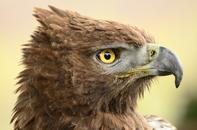
Kites
Kites are named for their habit of hovering like kites when hunting. The Black-shouldered kite will hover at height while tracking its prey, before swooping down to catch the prey. Three species of kites occur in South Africa.Kestrels, Falcons and Hobbys
Falcons and kestrels are essentially the same, they are falcons. They have pointed wings and they do not build their own nests. They will nest in existing nests or some do not use a nest and lay their eggs on a ledge.
Falcons and kestrels have a bony nasal tube at the base of the bill that is thought to measure the speed of flights by air flow through it. To sub-divide between falcons and kestrels. Kestrels do not have moustachial stripes and primarily catch their prey on the ground.
Kestrels are smaller than falcons. Falcons hunt mostly avian prey in the air and have moustachial stripes or markings, with some only having these in the juvenile phase. There are 5 species of kestrel and 16 species of falcons found in South Africa.
The kestrels and falcons are of the Genus Falco, with the exception being the pygmy falcon of the Genus Polihierax.
Vultures
Vultures primarily do not have feet or talons designed for attacking or catching prey. They have long necks and very sparse or no feathers on their heads. (The palm nut and the bearded vulture are exceptions and have feathers on their heads.) All vultures are primarily scavengers.With nine species occurring locally, falling into different Genera Gyohierax, Gypaetus, Neophron, Necyrosyrtes, Gype, and Aegypius.
Eagles
Eagles have wings that are long and broad and have well developed fingertips or slotting. (The fingertips provide stability when soaring). Eagles have feathered legs, snake eagles are different here, as they have scales on their legs.
Aquila eagles have a very long hind talon for killing prey, used by piercing the vertebrae or skull of the prey. The 17 species of eagles are under the following Genera. Haliaeetus, Circaetus, Terathopius, Aquila, Polmaetus, Lophaetus and Stephanoaetus.
Hawks
Hawks are the broadest group. Hawks have a broad wing and a longish tail. The hawks include sparrowhawks, goshawks, harriers, marsh harriers, cuckoo hawks, buzzards, harrier-hawks and bat hawks.
Cuckoo hawks resemble some of the cuckoo’s, with one species found locally, Genus Aviceda The one species of Bat hawk in South Africa hunt bats and is of the Genus Macheiramphus. Harriers and marsh harriers use a slow flying hunting technique, including hovering, to harry their prey.
There are five species of harriers, including marsh harriers, under the Genus Circus. The 6 different species of Sparrowhawks hunt by chasing other birds with low and rapid flying attacks. They are found under the Genus Accipiter. Buzzards have broader wings, with more pronounced fingertips.
There are seven local species of Buzzard under the following Genera, Buteo, Pernis and Kaupifalco. The three species of Goshawk, Genus Melierax, hunt with a slow and sedate flying pattern. Only one species of Harrier-hawk, the African Harrier-hawk is found in the region, with the Genus polyboroides. This bird was previously called a Gymnogene.